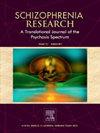确定治疗过的精神分裂症的累计发病率和精神病服务早期干预过渡的预测因素
IF 3.6
2区 医学
Q1 PSYCHIATRY
引用次数: 0
摘要
精神分裂症发病率的准确测量可以为公共政策提供信息,并确保有限资源的公平分配。首次接触病例低估了真实发病率,因为后来转变为精神分裂症。本研究旨在确定:(i)在早期精神病预防和干预中心(EPPIC)服务部门治疗期间诊断出的经DSM-5治疗的精神分裂症的24个月累积发病率,包括随后转变为精神分裂症诊断的首发精神病(FEP)病例;(ii)使用首次接触病例低估的程度;(iii)过渡到精神分裂症或双相情感障碍的比例和预测因素。方法本观察性研究纳入2011年至2016年在EPPIC服务的15-24岁人群中所有连续发生FEP的病例,数据采用前瞻性记录,但研究人员回顾性收集。泊松回归和Cox回归分别确定发病率比和风险比。结果:在1220名FEP年轻人中,17.2%的人被诊断为精神分裂症,而在中位93周(智商:62-106)后,30.2%的人被诊断为精神分裂症。首次接触诊断为精神分裂症的发病率为17.6 ~ 28.2 / 10万,累计发病率为28.2 ~ 42.3 / 10万。累积法诊断精神分裂症的发生率高出57% (IRR = 1.57, ci = 95%)。: 1.30-1.90,p <;措施)。出院时,30.2%符合精神分裂症标准,16.3%符合双相情感障碍标准。结论考虑到研究的局限性,如受试者的年龄范围较窄,应使用精神分裂症的累积发病率来确定更准确的发病率。本文章由计算机程序翻译,如有差异,请以英文原文为准。
Determining the cumulative incidence of treated schizophrenia and predictors of transition in an early intervention for psychosis service
Background
The accurate measurement of the incidence of schizophrenia can inform public policy and ensure equitable allocation of limited resources. First contact cases under-estimates the true incidence because of later transitions to schizophrenia. This study aimed to determine the:(i)24 months cumulative incidence of treated DSM-5 schizophrenia diagnosed during treatment at the Early Psychosis Prevention and Intervention Centre (EPPIC) service by including cases of first episode psychosis (FEP) which subsequently transitioned to a diagnosis of schizophrenia; (ii) extent of the under-estimation by using first contact cases; and (iii) proportion and predictors of transition to schizophrenia or bipolar disorder.
Methods
This observational study included all consecutive cases of FEP for people aged 15–24 who attended the EPPIC service from 2011 to 2016, data was recorded prospectively but collected by researchers retrospectively. Poisson regression and Cox regression were used to determine incidence rate ratios and hazard ratios respectively.
Results
At presentation, of the 1220 young people with a FEP, 17.2 % had a diagnosis of schizophrenia compared to 30.2 % after a median of 93 weeks (I.Q.R.: 62–106). The incidence rates of first contact diagnosis of schizophrenia ranged from 17.6 to 28.2 per 100,000 and the cumulative incidence rate ranged from 28.2 to 42.3. The incidence of schizophrenia was 57 % higher with the cumulative method (IRR = 1.57,95%C.I.: 1.30–1.90,p < .001). At discharge, 30.2 % met criteria for schizophrenia and 16.3 % for bipolar disorder.
Conclusions
Even when considering the limitations of the study, such as the narrow age bracket of the participants, the cumulative incidence of schizophrenia should be used to determine a more accurate incidence.
求助全文
通过发布文献求助,成功后即可免费获取论文全文。
去求助
来源期刊

Schizophrenia Research
医学-精神病学
CiteScore
7.50
自引率
8.90%
发文量
429
审稿时长
10.2 weeks
期刊介绍:
As official journal of the Schizophrenia International Research Society (SIRS) Schizophrenia Research is THE journal of choice for international researchers and clinicians to share their work with the global schizophrenia research community. More than 6000 institutes have online or print (or both) access to this journal - the largest specialist journal in the field, with the largest readership!
Schizophrenia Research''s time to first decision is as fast as 6 weeks and its publishing speed is as fast as 4 weeks until online publication (corrected proof/Article in Press) after acceptance and 14 weeks from acceptance until publication in a printed issue.
The journal publishes novel papers that really contribute to understanding the biology and treatment of schizophrenic disorders; Schizophrenia Research brings together biological, clinical and psychological research in order to stimulate the synthesis of findings from all disciplines involved in improving patient outcomes in schizophrenia.
 求助内容:
求助内容: 应助结果提醒方式:
应助结果提醒方式:


